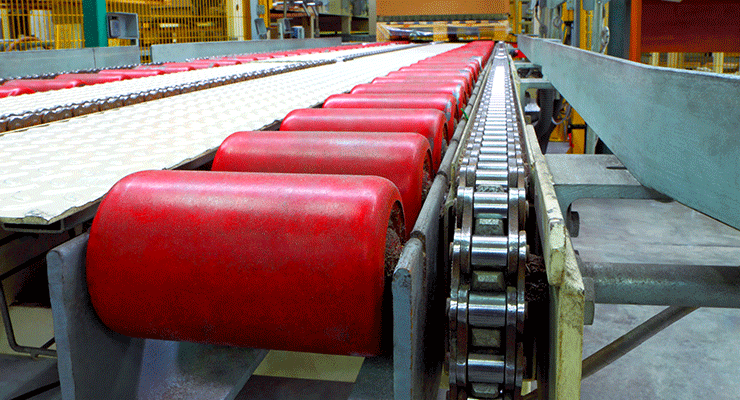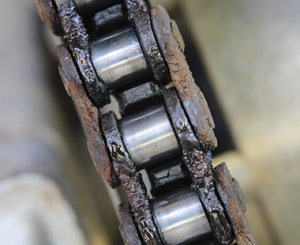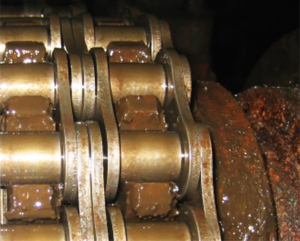 Chains are the workhorses of many industrial production processes. But as important as chains are in the day-to-day functions of many plant operations, chain lubrication and maintenance is often an afterthought.
Chains are the workhorses of many industrial production processes. But as important as chains are in the day-to-day functions of many plant operations, chain lubrication and maintenance is often an afterthought.
The reality is that internal chain wear (especially in the popular metal-pin-and-bushing chain type) can put a real kink in production up-time if not recognized and addressed early. Keeping chains in good condition is a relatively easy fix with proper lubrication selection and maintenance, and regular monitoring.
The Benefits of a Solid Chain Lubrication Program
An effective chain lubrication program can:
- Improve chain life by as much as 2-4X
- Reduce energy consumption by 5-10%
- Cut lubricant use by 50%
- Protect the chain against corrosion and help to keep out debris and contaminants the inside the chain
The end result is increased reliability with smooth chain operation.
Lubricant Properties Needed for Effective Chain Lubrication
At one point in time, chains were removed, cleaned with a solvent, and put in a hot oil bath. That was an effective process, but at present there are much more efficient lubrication technologies that make chain maintenance easier.
Look for chain lubricants that offer:
- The ability to permeate the interior of the chain to get in between the pin and bushing
- High-film strength to prevent excessive metal-to-metal contact
- The ability to remove residue that builds up on the inside and outside of the chain
- Adherence/ability to maintain a film – this is important for applications involving water, high temperatures, or high load
Are Your Chains Already Dehydrated?
 They say that when a human is feeling thirsty, he or she is already dehydrated and actually missed the need for fluid hours before. Adequate chain lubrication is a similar dilemma. Often chains are lubricated to salvage them long after a lack of lubrication created problems that can’t be resolved. Without lubrication, metal-to-metal contact will cause wear and elongation, reducing chain life.
They say that when a human is feeling thirsty, he or she is already dehydrated and actually missed the need for fluid hours before. Adequate chain lubrication is a similar dilemma. Often chains are lubricated to salvage them long after a lack of lubrication created problems that can’t be resolved. Without lubrication, metal-to-metal contact will cause wear and elongation, reducing chain life.
- Watch & Listen: As soon as chains start to become noisy and stiffen, lubricate immediately and arrive at a lubrication frequency. Read the information below to determine if you are lubricating in the correct location with the optimal lubrication technology/product.
- “Chain Stretch” is another sign of poor chain lubrication. This is known as chain elongation, which is caused by internal wear and lack of proper lubrication.
- A chain elongation gauge can help you figure out the best time for chain replacement. The limit on elongation is typically 2.5-3%.
- Elongation beyond 3% will lead to addition costs so you should order a new chain as soon as possible. A short term fix of chain adjustment or removal of links will not truly repair the chain, and the chain will likely break again when you least expect it. These are the kinds of warning signs that are often ignored, leading to chain breaks at the most inopportune times!
- Check the chain where there is heavy motion between the pin and bushing. An example is a chain hoist in which some of the chain receives heavy pressure and some barely move at all. Make sure you check for elongation in the area most impacted by tension.
- Areas of “Close Tolerance:” There are many reasons for chain failure, but perhaps the most common is internal wear of the pin and bushing – the parts that are fit to close tolerances. This is the area where the chain bears the load and flexes. Consider it the “bearing” area of the chain. It needs re-lubrication on a regular basis.
The How & Where of Lubricating Chains
Methods
There are three main categories for chain lubrication maintenance. Often the chain’s size, speed, and operating conditions will dictate which method is best.
- Manual Lubrication: Applying a lubricant via a brush or oil can, typically while equipment runs at lower speeds. This method can be used for conveyors, elevators, and drives.
- Semi-Automatic Lubrication: Typically involves a drip cup and uses a contact brush or direct dip. Sometimes used for conveyors and elevators, or drives in low horsepower and speed ranges.
- Automatic Lubrication:
- Splash method: The chain dips into an oil bath. Used on low to moderately operating drives.
- Oil disc: Throws the lubricant up onto the chain. Best for drives working at moderate to high horsepower and speed.
- Forced lubrication: An automatic, timed spray to an exact location. For high horsepower and speed drives.
Horsepower rating tables published by the American National Standards Institute (ANSI) provide guidelines for selecting the correct type of lubrication system based on the size (number of teeth) and speed (rpm) of the smallest sprocket. As a general rule, higher speeds and loads require more sophisticated lubrication systems.
Location
Apply the lubricant before a sprocket or sheave since this is where the chain flexes the most and will assist in the lubricant’s penetration.
- For high temperature applications: lubricate before the chain enters the heated area and again on the return after it has cooled.
- Ideal lubrication point: Between the side plates to allow the lubricant to seep in between the plates and along the bushing.
Frequency
- Variables: The time between lubrication depends on the chain design, the application environment (water/heat/debris), and speed.
- Early Cues: As noted previously, picking up on early cues before the chain gets too impacted by lack of lubrication is the best way to figure out the optimal frequency.
- Amperage as an Indicator: The amperage draw of equipment can also be used to judge lubrication frequency as long as there is a consistent load. Increased amperage tells you that the chain is working harder and needs re-lubrication. Once lubrication is completed, amperage should return to baseline. Make note of the intervals for your maintenance records.
 Choice of Lubricant
Choice of LubricantSelecting the optimal lubricant for the job is dictated by operating conditions. The following are the most common lubricants/applications:
- Petroleum-Based Lubricants: Economical lubricants used in applications up to 250°F (120°C).
- Open-Gear Lubricants: Tacky lubricants often used on the surface of open gears and often used along with a petroleum-based internal lubricant on the chain exterior. Unlike grease, open-gear lubricants don’t squeeze out under high pressure. In very dusty environments, they tend to collect dirt.
- High-Temperature Lubricants: Synthetic lubricants with improved oxidation stability are often used in operating conditions up to 520°F (270°C). These are typically based on polyalfaolefins (PAOs), polyalkalene glycols (PAGs) or esters (such as di-ester or polyol ester). Evaporation rate and the formation of residues at higher temperatures are the biggest concerns with this lubricant.
- Extreme High-Temperature Lubricants: The only option here are solid lubricants, which may include:
- Graphite Lubricants: Suitable for operating conditions of 1000°F (540°C).
- MoS2 Lubricants: 840°F (450°C)
- Copper, Nickel, or Inorganic Powders: Up to 2600°F (1425°C)
- Incidental Food Contact – NSF registered H1 Lubricants: Required where food contact is possible
- Dry Chain Lubricants (such as microscopic PTFE powder): Often used where any liquid may contaminate the product. Up to 4X longer chain life is possible with lubrication compared to none at all.
NOTE: Plastic chains are frequently promoted as self-lubricated, but a silicone-based chain lubricant can be beneficial. These applications can be plastic-to-metal or plastic-to-plastic.
The bottom line – don’t be resigned into thinking that the chains in your operation will automatically have a short life cycle. With the right lubricant and the right attention, those chains will hold up when you need them most.
For more in-depth information, watch this free webinar on “The Energy Efficiency of Chain Lubrication.”